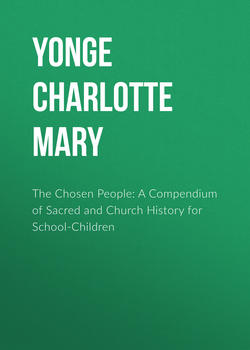Читать книгу The Chosen People: A Compendium of Sacred and Church History for School-Children - Yonge Charlotte Mary - Страница 11
LESSON XI
BABYLON
Оглавление"By the waters of Babylon we sat down and wept, when we remembered thee, O Sion."—Psalm cxxxvii, 1.
Babylon, the city which was to be the place of captivity of the Jews, was the home of the Chaldeans, who are believed not to have been the sons of Gush, like the Assyrians whom they had conquered at Nineveh, but to have been at first a wandering tribe of the north, and to have descended from Japhet. They had nearly the same gods as the Ninevites, but thought the special protector of their city was Bel-Merodach, the name by which they called the planet Jupiter. They were such great observers of the courses of the stars, that astronomy is said to have begun with them; but this was chiefly because they fancied that the heavenly bodies would help them to foretel coming events, for they put great faith in soothsayers. They settled upon the bank of the Euphrates, near the ruins of the Tower of Babel, round which a city arose, sometimes free, sometimes under the power of the King of Nineveh.
In the time of the weak and luxurious Saracus, Nabopolassar was governor of Babylon. He joined himself to the Medea, giving his son, Nebuchadnezzar, in marriage to the Median Princess Amytis; and as has already been said, the two nations together destroyed Nineveh, after which, Babylon became the head of the Assyrian Empire, and Nebuchadnezzar was the king.
He made the city exceedingly grand and beautiful. It was fifty five miles in circuit, square, surrounded by a wall eighty-seven feet thick, and three hundred and fifty high, with houses and a street on the top, and an enormous ditch filled with water all round, another lesser wall some way within. There were one hundred brazen gates in the wall, besides two larger gateways upon the Euphrates, which ran through the middle, dividing the city into two parts. It was full of streets and houses, with such fields and vineyards, that it was like a whole country walled in; and the soil was exceedingly rich, being all brought down from the Armenian hills by the Euphrates. As this river rose in the mountains of Armenia, it used to overflow in the spring, when the snows melted and swelled the stream; but to prevent mischief, the country was covered with a network of canals, to draw off the water in safety. The pride of the city was the Temple of Bel, which is thought to have been built on a fragment of the Tower of Babel. It was a pile of enormous height, with seven stages in honour of the seven planets then known, and with a winding ascent leading from one to the other. On the top was the shrine, where stood Bel's golden image, twelve cubits high, and before it a golden table where meats and wine were served up to him. On either side of the river were two palaces, joined together by a bridge, and the nearer one, four miles round, with wonderful grounds, containing what were called the hanging gardens, namely, a hill which Nebuchadnezzar had caused to be raised by heaping up earth, and planted with trees, to please his Median queen, whose eye pined for her native mountains in the flats of Babylon.
